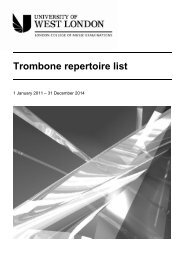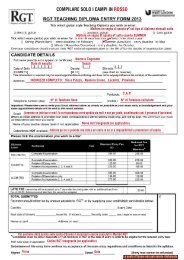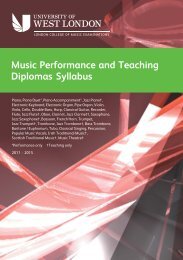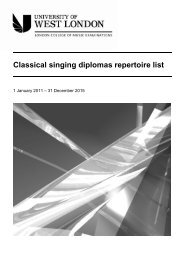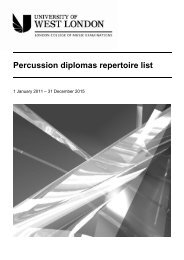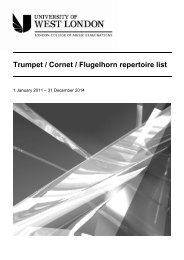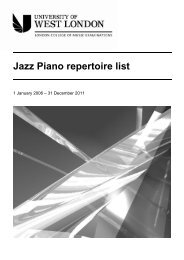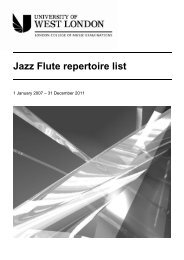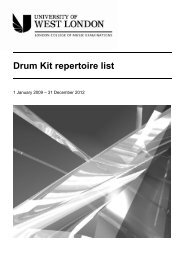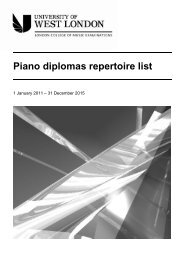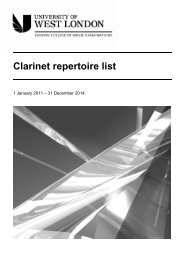Classical saxophone repertoire list - esamilcm.it
Classical saxophone repertoire list - esamilcm.it
Classical saxophone repertoire list - esamilcm.it
- No tags were found...
Create successful ePaper yourself
Turn your PDF publications into a flip-book with our unique Google optimized e-Paper software.
<strong>Classical</strong> <strong>saxophone</strong> <strong>repertoire</strong> <strong>list</strong>1 January 2011 – 31 December 2014
CLASSICAL SAXOPHONE2011-2014ContentsPageLCM Publications ................................................................. 3Related Examinations .......................................................... 3Introduction .......................................................................... 3Step 1 .................................................................................. 4Step 2 .................................................................................. 5Grade 1 ................................................................................ 6Grade 2 ................................................................................ 8Grade 3 ................................................................................ 10Grade 4 ................................................................................ 12Grade 5 ................................................................................ 14Grade 6 ................................................................................ 16Grade 7 ................................................................................ 18Grade 8 ................................................................................ 20Viva Voce ............................................................................. 22Aural Tests ........................................................................... 24This <strong>repertoire</strong> <strong>list</strong> should be read in conjunction w<strong>it</strong>h the Syllabus for Gradedand Leisure Play Examinations in Music Performance. Copies are availablefree of charge from LCM Examinations (tel: 020 8231 2364) or from localrepresentatives, or on uwl.ac.uk/lcmexams.Leisure Play examinations are also available, for candidates who wish to playpieces only. Please see Section 5 of the syllabus for details.This <strong>repertoire</strong> <strong>list</strong> is valid from 1 January 2011 until 31 December 2014.
LCM ExaminationsDirector of ExaminationsJohn Howard BA PhDChief Examiner in MusicPhilip Aldred BEd FLCMUnivers<strong>it</strong>y of West LondonLCM ExaminationsSt Mary’s RoadEalingLondonW5 5RFtel: +44 (0)20 8231 2364fax: +44 (0)20 8231 2433email: lcm.exams@uwl.ac.ukuwl.ac.uk/lcmexams© Copyright 2011 by the Univers<strong>it</strong>y of West London, LCM Examinations2
AcknowledgementGrateful thanks are due to Stuart Corbett, the principal syllabus compiler.LCM PublicationsThe following LCM Publications are relevant to this syllabus:• Specimen Saxophone Sight Reading Tests: Grades (LL11890)• Specimen Aural Tests (LL189)• LCM Aural Handbook: A Practical Guide to Teaching and Preparing for LCM Aural Tests (LL205)LCM Publications are distributed by Music Exchange (tel: 0161 946 9301; email: mail@music-exchange.co.uk).A complete <strong>list</strong> of t<strong>it</strong>les may be found on their webs<strong>it</strong>e – www.music-exchange.co.ukRelated ExaminationsLCM Examinations offers examinations in a wide range of subjects, covering classical, jazz, pop/rock and trad<strong>it</strong>ionalmusic genres. The following syllabuses may also be of interest:• Graded and leisure play examinations for jazz <strong>saxophone</strong>• Performance diplomas (four levels) for <strong>saxophone</strong> and jazz <strong>saxophone</strong>• Teaching diplomas (three levels) for <strong>saxophone</strong> and jazz <strong>saxophone</strong>A flexible Ensemble syllabus is also available, catering for all types of ensemble from duets and trios up to concert bandsand wind bands. Six levels are offered, ranging from Grades 1-2 to DipLCM standard.Syllabuses are available free of charge from the LCM Exams office or from local representatives, or may be downloadedfrom the LCM Exams webs<strong>it</strong>e.IntroductionThis syllabus reflects the fact that the <strong>saxophone</strong> is not only a solo instrument, but is also an ensemble instrument,whether in the context of a band or orchestra, or a smaller ensemble such as a <strong>saxophone</strong> quartet or rock group.Therefore <strong>it</strong> includes some <strong>it</strong>ems which reflect links w<strong>it</strong>h a variety of styles. W<strong>it</strong>h this in mind, the demands of goodensemble awareness are recognised from the early grades upwards in the option of a duet study: this should encouragethe student to recognise the importance of technical elements related to intonation, balance, tone and rhythmic secur<strong>it</strong>y.The Technical Work components have been structured so that the candidate can gradually accumulate technical fluencyand grammatical awareness over the complete range of the instrument. Extremes of register are approached step bystep. At higher grades, when candidates should be more technically assured, maximum flexibil<strong>it</strong>y is allowed in relation tochoice of instrument, in order to encourage the candidate to offer a musically fulfilling performance.The importance of reference material which is helpful throughout the grades is acknowledged. Therefore, some studybooks can be used through a number of grades.At Grades 1-3, candidates should use one instrument only. Candidates may use one or more instruments at Grades 4-8.Pieces in List B should generally be accompanied, unless indicated otherwise.If a piece appears at more than one grade, greater skill levels and interpretation qual<strong>it</strong>ies will be expected at the highergrade.Where the <strong>repertoire</strong> <strong>list</strong> indicates tenor <strong>saxophone</strong>, the piece may also be played on soprano <strong>saxophone</strong>.3
CLASSICAL SAXOPHONE: STEP ONEAny type of <strong>saxophone</strong> may be used. However, candidates are not allowed to change instruments during theexamination.The exercises must both be taken from the same book. The pieces may be taken from any of the set books. Some of thepieces and exercises are duets. This is to encourage ensemble awareness. The teacher or a friend may wish to play thelower part.Component 1 - Exercises25 marksE<strong>it</strong>her: Ex.2 and Ex.3 (un<strong>it</strong> 3, page 10) Learn As You Play Saxophone (Boosey & Hawkes)Or: Ex.3 and Ex.4 (level 1) Teacher On Tap Book 1: Starting Out (Teacher On Tap)Or: No.5 and No.6 (lesson 3, page 5) Tune A Day Saxophone [original ed<strong>it</strong>ion] (Boston Music)Component 2 - Pieces60 marksAny three of the following to be chosen:Clown Dance Abracadabra Saxophone (A&C Black)Fais Do-Do Abracadabra Saxophone (A&C Black)On The Road Abracadabra Saxophone (A&C Black)Minuetto (un<strong>it</strong> 2, page 9) Learn As You Play Saxophone (Boosey & Hawkes)Swim, Swan, Swim (un<strong>it</strong> 3, page 10) Learn As You Play Saxophone (Boosey & Hawkes)Boogaloo (level 1) Teacher On Tap Book 1: Starting Out (Teacher On Tap)ANY duet [upper part] (lesson 2, page 4) Tune A Day Saxophone [original ed<strong>it</strong>ion] (Boston Music)Component 3 - Questions on Rudiments15 marksRecogn<strong>it</strong>ion/identification of stave, barlines, p<strong>it</strong>ch names, note types and values, rest values, all relating tothe music performed. The importance of looking after the instrument (e.g. keeping the mouthpiece clean, thepull-through, looking after reeds).4
CLASSICAL SAXOPHONE: STEP TWOAny type of <strong>saxophone</strong> may be used. However, candidates are not allowed to change instruments during theexamination.The exercises must both be taken from the same book. The pieces may be taken from any of the set books. Some of thepieces and exercises are duets. This is to encourage ensemble awareness. The teacher or a friend may wish to play thelower part.Component 1 - Exercises25 marksScale and arpeggio of D major (tongued and slurred), one octave ascending and descending, from memory[illustrated in Tune A Day Saxophone, page 16 (in crotchets) OR Learn As You Play Saxophone, page 21]andE<strong>it</strong>her: Ex.2 and Ex.3 (un<strong>it</strong> 4, page 12) Learn As You Play Saxophone (Boosey & Hawkes)Or: Ex.8 and Ex.9 (level 1) Teacher on Tap Book 1: Starting Out (Teacher on Tap)Or: Ex.2 and Ex.5 (lesson 5A ‘slurred notes’, page 9) Tune A Day Saxophone [original ed<strong>it</strong>ion] (Boston Music)Component 2 - Pieces60 marksAny three of the following to be chosen:Long Long Ago (page 28) Abracadabra Saxophone (A&C Black)Polly-Wolly-Doodle (page 25) Abracadabra Saxophone (A&C Black)One Potato New Alto (Tenor) Solos Book 1 (Useful Music)Chorale Melody (un<strong>it</strong> 3, page 11) Learn As You Play Saxophone (Boosey & Hawkes)Heroic Song in Phrygian Mode (un<strong>it</strong> 3, page 11) Learn As You Play Saxophone (Boosey & Hawkes)March (un<strong>it</strong> 4, page 13) Learn As You Play Saxophone (Boosey & Hawkes)Mexican Madness [duet, upper part] (un<strong>it</strong> 4) Learn As You Play Saxophone (Boosey & Hawkes)Introducing the Eighth Note (Quaver) (level 1) Teacher On Tap Book 1: Starting Out (Teacher On Tap)Lightly Row (lesson 5A, page 9) Tune A Day Saxophone [original ed<strong>it</strong>ion] (Boston Music)Twinkle Twinkle L<strong>it</strong>tle Star (lesson 5, page 8) Tune A Day Saxophone [original ed<strong>it</strong>ion] (Boston Music)Component 3 - Questions on Rudiments15 marksAs for Step 1, including looking after the instrument, plus dotted note values and knowledge about the purposeof the key signature and time signature, accidentals and basic dynamic signs. All relating to the music performed.5
CLASSICAL SAXOPHONE: GRADE ONEComponent 1 - Technical Work15 marksScales and Arpeggios (ascending and descending from memory)(suggested tempo: m.m. crotchet = 60 when played in quavers)to be played tongued and slurred:G and F major (one octave)A harmonic OR melodic minor (candidate’s choice) (one octave)Component 2 - Performance60 marksPerformance of three pieces: one piece from List A and two contrasting pieces from List B.LIST A Alto/Bar<strong>it</strong>one and Soprano/TenorBULLARD Hungarian Sax (No.7) OR Balanced Sax (No.8) from Sixty for Sax (ABRSM)DIABELLI Serenade (p.19) from Learn As You Play Saxophone (Boosey & Hawkes)GARIBOLDI No.1 OR No.3 from Easy <strong>Classical</strong> Studies (ed. Harle) (Universal)GUMBLEY Frog Hop OR Chant from Cool School (Brass Wind)HARRIS Study 4 OR 8 OR 10 from 80 Graded Studies for Saxophone Book 1 (Faber)LONDEIX Shepherdess’s Spinning Song OR My Friends the Animals from Playing the Saxophone Book 1(Lemoine / UMP)LYONS No.3 OR No.4 from 24 Melodic Studies for Saxophone (Useful Music)PERCIVAL Ex.3 OR Ex.4 OR Ex.6 (Level 2) from Teacher on Tap Book 1: Starting Out (Teacher On Tap)RAE First Take OR Leap Frog from Easy Studies in Jazz and Rock Saxophone (Universal)LIST B Alto/Bar<strong>it</strong>oneBARTÓK Dialogue from The Magic Saxophone (Boosey & Hawkes)BOYLE Fresh Air Waltz OR Memories from Dances and Daydreams for Alto Sax and Piano (Boosey & Hawkes)FOSTER Beautiful Dreamer (arr. De Smet) (Fentone WA6001401)GURLITT Andante from Learn As You Play Saxophone (Boosey & Hawkes)[piano accompaniment available separately]HOUNSOME Activate OR Spirals from Upbeat Book 1 (Music Exchange)HYDE Soliloquy from Learn As You Play Saxophone (Boosey & Hawkes)[piano accompaniment available separately]LYONS One Potato from New Alto Saxophone Solos Book 1 (Very Easy / Medium) (Useful Music)PERCIVAL Pavane OR Nashville Express OR Valse Vierd (Level 1) from Teacher On Tap Book 1: Starting Out(Teacher On Tap)STRAUSS Rose from the South from The Joy of Saxophone (Yorktown / Music Sales)TRAD. Scarborough Fair OR Amazing Grace OR Morning Has Broken from Skill Builders forAlto Sax (arr. Isacoff)(G. Schirmer / Music Sales)TRAD. Song of the Volga Boatmen from The Magic Saxophone (Boosey & Hawkes)WEDGWOOD Cheeky Cherry OR Wrap It Up from Really Easy Jazzin' About (Faber)WEDGWOOD I Believe from Up-Grade 1-2 (Faber)LIST B Soprano/TenorALAN And All That Jazz from 1st Rec<strong>it</strong>al Series (Curnow)[accompaniment available, or may be played w<strong>it</strong>h CD backing]GORB Aria from Up Front Album for B flat Sax (Brass Wind)GRETRY Air from Richard Coeur de Lion from Learn As You Play Saxophone (Boosey & Hawkes)[piano accompaniment available separately]GURLITT Andante (arr. Wastall) from Learn As You Play Saxophone (Boosey & Hawkes)[piano accompaniment available separately]HANDEL Sarabande (arr. Both) from <strong>Classical</strong> Saxophone Solos (Tenor) (Schott 7330)HAYDN Minuet (arr. Harle) from <strong>Classical</strong> Album: Saxophone (Universal)LEWIN Heat Haze from Up Front Album for B flat Sax (Brass Wind)6
LINDSAY Memoir from First Rec<strong>it</strong>al Series [accompaniment available, or may be played w<strong>it</strong>h CD backing] (Curnow)MOURET Musette from Dances from the French Operas: Tenor Sax Vol.1 (Studio Music)PERCIVAL Pavane OR Nashville Express OR Valse Vierd (Level 1) from Teacher On Tap Book 1: Starting Out(Teacher On Tap)SCHEIN Allemande and Tripla (arr. Both) from <strong>Classical</strong> Saxophone Solos (Tenor) (Schott 7330)WEDGWOOD I Believe from Selected Solos for Soprano / Tenor Saxophone (Faber)Component 3 - Viva Voce7 marksSee pages 22-23.Component 4 - Sight Reading10 marksUp to one minute’s preparation time will be allowed to study the test before playing, during which the candidatemay try parts of the test if they wish. Specimen tests are available (LL11890).Component 5 - Aural Tests8 marksSee pages 24-28. Specimen tests and a handbook are available (details on page 3).7
CLASSICAL SAXOPHONE: GRADE TWOComponent 1 - Technical Work15 marksScales and Arpeggios (ascending and descending, from memory)(suggested tempo: m.m. crotchet = 60 when played in quavers)to be played tongued and slurred in the following keys and ranges:C, G, F and B flat major (one octave); D major (two octaves)A and E harmonic OR melodic minor (candidate’s choice) (one octave)D harmonic OR melodic minor (candidate’s choice) (two octaves)Component 2 - Performance60 marksPerformance of three pieces: one piece from List A and two contrasting pieces from List B.LIST A Alto/Bar<strong>it</strong>one and Soprano/TenorBAERMANN Study 12 OR 17 from 80 Graded Studies for Saxophone Book 1 (Faber)BULLARD Sax Rock (No.11) OR Sax Fanfare (No.14) from Sixty for Sax (ABRSM)CHEDEVILLE Gavotte (p.33) from Learn As You Play Saxophone (ed. Wastall) (Boosey & Hawkes)GUMBLEY Tongue and Groove from Cool School (Brass Wind)LONDEIX Blue Bird OR La Maumariée from Playing The Saxophone Book 1 (Lemoine / UMP)LYONS No.8 OR No.12 from 24 Melodic Studies for Saxophone (Useful Music)MADDEN Silver Riddle from 20 Sensational Saxophone Studies (Rothco Music)PERCIVAL Ex.3 OR Ex.4 OR Ex.5 (Level 3) from Teacher On Tap Book 1: Starting Out (Teacher On Tap)POPP Study 10 OR 24 from Easy <strong>Classical</strong> Studies (ed. Harle) (Universal)RAE Over and Out OR Flapjack OR Overdrive from Easy Studies in Jazz and Rock (Universal)LIST B Alto/Bar<strong>it</strong>oneBYRDPavane for the Earl of Salisbury from Saxophone Solos Vol.1 (Alto)(ed. Harvey)(Chester / Music Sales)HOUNSOME Floating Downstream (No.3) from Upbeat Book 1 (Music Exchange)LINGEN Sax Parade OR Bossa Brazil from Saxophone Rec<strong>it</strong>al [may be played w<strong>it</strong>h CD backing] (De Haske)LYONS Rock Steady from New Alto Saxophone Solos Book 1 (Very Easy / Medium) (Useful Music)MOZART Minuet from <strong>Classical</strong> Album: Saxophone (arr. Harle) (Universal)NAULAIS Coconotes (Billaudot / UMP)OFFENBACH Barcarolle from <strong>Classical</strong> Saxophone Solos (arr. Both) (Schott 73331)PERCIVAL March of the Nerds OR Minuet and Trio from Teacher On Tap Book 1: Starting Out (Teacher On Tap)SCHUBERT The Trout from The Joy of Saxophone (Yorktown / Music Sales)TCHAIKOVSKY Chanson Triste from <strong>Classical</strong> Album: Saxophone (arr. Harle) (Universal)TRAD.Greensleeves OR Skillbuilders from Skillbuilders for Alto Saxophone (arr. Isacoff)(G. Schirmer / Music Sales)TRAD. Skye Boat Song from The Magic Saxophone (Boosey & Hawkes)WASTALL Midnight in Tobago from Learn As You Play Saxophone (Boosey & Hawkes)[piano accompaniment available separately]WEDGWOOD All in a Day’s Work from Up-Grade 2-3 (Faber)WEDGWOOD Dragonfly from Really Easy Jazzin’ About (Faber)LIST B Soprano/TenorBRAHMS Sunday (arr. Harle) from <strong>Classical</strong> Album for Sax (Universal)COUPERIN Gavotte from <strong>Classical</strong> Sax Solos (Tenor) (arr. Both) (Schott 7330)HANNICKEL The Matador from 1st Rec<strong>it</strong>al Series (Curnow)[accompaniment available, or may be played w<strong>it</strong>h CD backing]HARRIS Foxtrot from First Repertoire Pieces Saxophone (Tenor) (Boosey & Hawkes)LEDBURY Takin’ It Easy from All Jazzed Up for Saxophone (Brass Wind)LYONS Wheels W<strong>it</strong>hin Wheels OR Laura’s Lament from New Tenor Sax Solos Book 1 (Useful Music)MACDOWELL To a Wild Rose from 1st Rec<strong>it</strong>al Series (Curnow)8
[accompaniment available, or may be played w<strong>it</strong>h CD backing]MOZART Minuet from <strong>Classical</strong> Album: Saxophone (Tenor) (arr. Harle) (Universal)PERCIVAL March of the Nerds OR Minuet and Trio from Teacher On Tap Book 1: Starting Out (Teacher On Tap)RAYE I’ll Remember April from Jazz and Blues Greats (Wise / Music Sales)TCHAIKOVSKY Chanson Triste OR Old French Song from <strong>Classical</strong> Album: Saxophone (Tenor) (arr. Harle) (Universal)TRAD. Peruvian Dance Tune from Amazing Solos for the Tenor Sax Player (Boosey & Hawkes)VERDI La Donna e Mobile from Selected Solos for Soprano/Tenor Saxophone Grades 1-3 (Faber)WASTALL Midnight in Tobago from Learn As You Play Saxophone (Boosey & Hawkes)[piano accompaniment available separately]Component 3 - Viva Voce7 marksSee pages 22-23.Component 4 - Sight Reading10 marksUp to one minute’s preparation time will be allowed to study the test before playing, during which the candidatemay try parts of the test if they wish. Specimen tests are available (LL11890).Component 5 - Aural Tests8 marksSee pages 24-28. Specimen tests and a handbook are available (details on page 3).9
CLASSICAL SAXOPHONE: GRADE THREEComponent 1 - Technical Work15 marksScales and Arpeggios (ascending and descending, from memory)(Suggested tempo: m.m: crotchet = 60 when played in quavers)to be played tongued and slurred in the following keys and ranges:C and E flat major (two octaves); G, A, F and B flat major (one octave)D and C harmonic OR melodic minor (candidate’s choice) (two octaves)A, G, B and E harmonic OR melodic minor (candidate’s choice) (one octave)Component 2 - Performance60 marksPerformance of three pieces: one piece from List A and two contrasting pieces from List B.LIST A Alto/Bar<strong>it</strong>one and Soprano/TenorBRIARD Study No.1 (p.4) from Learn As You Play Saxophone (ed. Wastall) (Boosey & Hawkes)BULLARD Classic Sax (No.21) OR Staccato Sax (No.22) from Sixty for Sax (ABRSM)GARNIER Study No.21 from 80 Graded Studies for Saxophone Book 1 (Faber)GUMBLEY Blue Funk OR Skedaddle from Cool School (Brass Wind)KÖHLER Study 20 OR 29 from Easy <strong>Classical</strong> Studies (ed. Harle) (Universal)LONDEIX The Seeds of Love from Playing the Saxophone Book 1 (Lemoine / UMP)LYONS No.10 OR No.13 from 24 Melodic Studies for Saxophone (Useful Music)PERCIVAL Ex.7 OR Ex.9 OR Ex.10 (Level 4) from Teacher On Tap Book 1: Starting Out (Teacher On Tap)RAEIn the Beginning OR Freeway OR Discomatic from Easy Studies in Jazz and Rock Saxophone(Universal)LIST B Alto/Bar<strong>it</strong>oneANON. Nana and El Paño (arr. Lewin) from Twenty Two Unaccompanied Pieces for Saxophone (ABRSM)BACH, J S Gavotte from French Su<strong>it</strong>e No.5 (arr. Lewin) from Twenty Two Unaccompanied Pieces for Saxophone(ABRSM)BENJAMIN Jamaican Rumba from Learn As You Play Saxophone (ed. Wastall) (Boosey & Hawkes)[piano accompaniment available separately]FINZI Carol from Learn As You Play Saxophone (ed. Wastall) (Boosey & Hawkes)[piano accompaniment available separately]GERSHWIN Summertime from Play Gershwin (E flat) (Faber)HANDEL Bourée from <strong>Classical</strong> Album for Alto Saxophone (arr. Harle) (Universal)HAYDN Serenade from <strong>Classical</strong> Album for Alto Saxophone (arr. Harle) (Universal)HOUNSOME Musical Box OR Just Lounging About from Upbeat Book 1 (Music Exchange)ILYNSKY Berceuse from First Repertoire Pieces For Alto Saxophone (Boosey & Hawkes)JOPLIN The Entertainer from Skill Builders for Alto Saxophone (ed. Isacoff) (G. Schirmer / Music Sales)LINGEN Pop Ballad OR Sax ‘o’ Funk from Saxophone Rec<strong>it</strong>al [may be played w<strong>it</strong>h CD backing] (De Haske)LYONSWheels W<strong>it</strong>hin Wheels from New Alto Saxophone Solos Book 1 (Very Easy / Medium) (Useful Music)PERCIVAL Last Tango in Coonabarabran OR Café Rio from Teacher On Tap Book 1: Starting Out(Teacher on Tap)RAE Waltz for Emily from Blue Saxophone (Universal)SCHUBERT Serenade from First Repertoire Pieces for Alto Saxophone (Boosey & Hawkes)SHOSTAKOVICH March from The Magic Saxophone(Boosey & Hawkes)STRAVINSKY Shrove Tide Fair Themes from The Magic Saxophone (Boosey & Hawkes)SULLIVAN The Sun and I from Saxophone Solos Vol.2 (Alto) (ed. Harvey) (Chester / Music Sales)VIZZUTTI Dream from Explorations [may be played w<strong>it</strong>h CD backing] (De Haske)WEDGWOOD Smooth Operator from Really Easy Jazzin’ About (Faber)10
LIST B Soprano/TenorANON. Nana and El Paño (arr. Lewin) from Twenty-Two Unaccompanied Pieces for Saxophone (ABRSM)BACH, J S Gavotte from French Su<strong>it</strong>e No.5 (arr. Lewin) from Twenty-Two Unaccompanied Pieces for Saxophone(ABRSM)BACH, J S Minuet from 1st Rec<strong>it</strong>al Series [accomp. available, or may be played w<strong>it</strong>h CD backing] (Curnow)BENJAMIN Jamaican Rumba from Learn As You Play Saxophone (Tenor Sax) (ed. Wastall) (Boosey & Hawkes)[piano accompaniment available separately]BRAHMS Waltz from 1st Rec<strong>it</strong>al Series [accomp. available, or may be played w<strong>it</strong>h CD backing] (Curnow)DVOŘÁK Slavonic Dance from 1st Rec<strong>it</strong>al Series (Curnow)[accompaniment available, or may be played w<strong>it</strong>h CD backing]FAURÉ Pavane from <strong>Classical</strong> Album for B flat Instruments Book 2 (Studio Music)FINZI Carol from Learn As You Play Saxophone (ed. Wastall) [tenor <strong>saxophone</strong>] (Boosey & Hawkes)[piano accompaniment available separately]GERSHWIN Summertime from Play Gershwin (B flat version) (Faber)HANDEL Bourée from <strong>Classical</strong> Album for Saxophone (arr. Harle) (Universal)HARRIS Showtime from Selected Solos for Soprano/Tenor Saxophone Grades 1-3 (Faber)HAYDN Serenade from <strong>Classical</strong> Album for Saxophone (arr. Harle) (Universal)ILYNSKY Berceuse from First Repertoire Pieces for Tenor Sax (ed. Wastall) (Boosey & Hawkes)KELLY Argumentative from Mood Pieces [soprano <strong>saxophone</strong>] (Stainer & Bell)KINYON Folk Song Blues from Learn As You Play Saxophone (Boosey & Hawkes)[piano accompaniment available separately]LYONS Soft Song OR Moonrock from New Tenor Sax Solos Book 1 (Useful Music)PERCIVAL Last Tango in Coonabarabran OR Café Rio from Teacher On Tap Book 1: Starting Out(Teacher on Tap)RAE Waltz for Emily from Blue Saxophone (Universal)SCHUBERT Serenade from First Repertoire Pieces for Tenor Sax (ed. Wastall) (Boosey & Hawkes)TRAD. The Welsh Pipers Melody from Tenor Saxophone Solos Vol.1 (ed. Harvey) (Chester / Music Sales)VAN GORP The Henley Regatta OR Go Out Shopping from Master Swop (Pop Swing): Tenor Sax (De Haske)[accompaniment available separately, or CD backing may be used]Component 3 - Viva Voce7 marksSee pages 22-23.Component 4 - Sight Reading10 marksUp to one minute’s preparation time will be allowed to study the test before playing, during which the candidatemay try parts of the test if they wish. Specimen tests are available (LL11890).Component 5 - Aural Tests8 marksSee pages 24-28. Specimen tests and a handbook are available (details on page 3).11
CLASSICAL SAXOPHONE: GRADE FOURN.B. At Grade 4-8 candidates may use one or more <strong>saxophone</strong>s.Component 1 - Technical Work15 marksScales and Arpeggios (ascending and descending, from memory)(suggested tempo: m.m. crotchet = 72 when played in quavers)to be played tongued and slurred in the following keys and ranges:C, D, E, F, B flat and E flat major (two octaves); G, A and A flat major (one octave)E, D and C harmonic OR melodic minor (candidate’s choice) (two octaves)A, B, F sharp and G harmonic OR melodic minor (candidate’s choice) (one octave)Chromatic scale starting on G (one octave)Component 2 - Performance60 marksPerformance of three pieces: one piece from List A and two contrasting pieces from List B.LIST A Alto/Bar<strong>it</strong>one and Soprano/TenorBAERMANN Study No.32 from 80 Graded Studies for Saxophone Book 1 (Faber)BRIARD Study No.3 (p.50) from Learn As You Play Saxophone (Boosey & Hawkes)BULLARD Show Stopping Sax (No.32) OR Roundabout Sax (No.31) from Sixty for Sax (ABRSM)GARIBOLDI Study No.42 from Easy <strong>Classical</strong> Studies (ed. Harle) (Universal)GUMBLEY Cheekie Charlie OR Blues for Caroline from Cool School (Brass Wind)LONDEIX Scottish Melody (p.34) from Playing The Saxophone Book 2 (Lemoine / UMP)LYONS No.14 from 24 Melodic Studies for Saxophone (Useful Music)PERCIVAL Ex.3 OR Ex.7 OR Ex.8 (Level 5) from Teacher On Tap Book 1: Starting Out (Teacher On Tap)RAE One Way Ticket OR Road Hog from Easy Studies in Jazz and Rock Saxophone (Universal)LIST B Alto/Bar<strong>it</strong>oneANON. The Golden Van<strong>it</strong>y (arr. Lewin) from Twenty-Two Unaccompanied Pieces for Saxophone (ABRSM)BACH, JS Minuet I OR II from Su<strong>it</strong>e No.1 (trans. Londeix) [solo <strong>saxophone</strong>] (Lemoine / UMP)BACH, JS Musette from First Repertoire Pieces for Alto Saxophone (Boosey & Hawkes)BLEMANT Pet<strong>it</strong> Jeu from First Repertoire Pieces for Alto Saxophone (Boosey & Hawkes)BLYTON In Memoriam of Scott F<strong>it</strong>zgerald from Sax Solos (Alto) Book 1 (ed. Harvey) (Chester / Music Sales)CHOPIN Nocturne from The Joy of Sax (Music Sales)HARE Banana Rag from The Magic Saxophone (Boosey & Hawkes)HOUNSOME Highland Caper from Upbeat Book 1 (Music Exchange)JOPLIN Magnetic Rag from Ragtime Favour<strong>it</strong>es [may be played w<strong>it</strong>h CD backing] (Fentone)LYONS Morning Glory from New Alto Saxophone Solos Book 2 (Useful Music)LYONSSweet and Sad OR Laura’s Lament from Alto Saxophone Solos Book 1 (Very Easy / Medium)(Useful Music)MALTBY Heather on the Hill from First Repertoire Pieces for Alto Saxophone (Boosey & Hawkes)PERCIVAL Adagio OR Polka (Level 4) from Teacher On Tap Book 1: Starting Out (Teacher on Tap)RACHMANINOV Romance from John Harle’s Sax Album(Boosey & Hawkes)RAE Vintage Blue from Blue Saxophone (Universal)TELEMANN Gavotte (arr. Lewin) from Twenty-Two Unaccompanied Pieces for Saxophone (ABRSM)VIZZUTTI Space OR Rain Forest from Explorations [may be played w<strong>it</strong>h CD backing] (De Haske)WEDGWOOD Sometime Maybe from Jazzin’ About (Faber)LIST B Soprano/TenorANON. The Golden Van<strong>it</strong>y (arr. Lewin) from Twenty-Two Unaccompanied Pieces for Saxophone (ABRSM)BACH, J S Minuet I OR II from Su<strong>it</strong>e No.1 (trans. Londeix) [solo <strong>saxophone</strong>] (Lemoine / UMP)BACH, J S Musette from First Repertoire Pieces for Tenor Sax (ed.Wastall) (Boosey & Hawkes)12
BEETHOVEN Scherzo from Solos for The Tenor Sax Player (ed.Teal) (G. Schirmer / Music Sales)BERNSTEIN America from Amazing Solos for Tenor Sax (Boosey & Hawkes)BIZET Seguidilla from Amazing Solos for Tenor Sax (Boosey & Hawkes)BLEMANT Pet<strong>it</strong> Jeu from First Repertoire Pieces for Tenor Sax (ed.Wastall) (Boosey & Hawkes)BLYTON Saxe Blue from Saxophone Solos Vol.1 (B flat Tenor) (Chester / Music Sales)COWLES Bala Ballade from Tenor Saxophone Solos Vol.2 (ed.Harvey) (Chester / Music Sales)CURNOWDivergents from 1st Rec<strong>it</strong>al Series (Curnow)[accompaniment available, or may be played w<strong>it</strong>h CD backing]HAYDN Serenade from 1st Rec<strong>it</strong>al Series (Curnow)[accompaniment available, or may be played w<strong>it</strong>h CD backing]JOPLIN Magnetic Rag from Ragtime Favour<strong>it</strong>es [may be played w<strong>it</strong>h CD backing] (Fentone)KELLY Cheerful from Mood Pieces [soprano <strong>saxophone</strong>] (Stainer & Bell)KELLY Sarabande from Don Quixote Su<strong>it</strong>e [soprano <strong>saxophone</strong>] (Emerson)LYONS Runway from New Tenor Sax Solos Book 1 (Useful Music)LYONS Set Free OR Butterfly Waltz from New Tenor Sax Solos Book 2 (Useful Music)MALTBY Heather on the Hill from First Repertoire Pieces for Tenor Sax (ed.Wastall) (Boosey & Hawkes)PERCIVAL Adagio OR Polka (Level 4) from Teacher On Tap Book 1: Starting Out (Teacher on Tap)PROKOFIEV Troika from Amazing Solos for Tenor Sax (Boosey & Hawkes)RAE Vintage Blue from Blue Saxophone (Universal)TELEMANN Gavotte (arr. Lewin) from Twenty-Two Unaccompanied Pieces for Saxophone (ABRSM)VAN GORP This is My OR Por Favor from Master Swop (Pop Swing) (De Haske)[accompaniment available separately, or CD backing may be used]Component 3 - Viva Voce7 marksSee pages 22-23.Component 4 - Sight Reading10 marksUp to one minute’s preparation time will be allowed to study the test before playing, during which the candidatemay try parts of the test if they wish. Specimen tests are available (LL11890).Component 5 - Aural Tests8 marksSee pages 24-28. Specimen tests and a handbook are available (details on page 3).13
CLASSICAL SAXOPHONE: GRADE FIVEN.B. At Grade 4-8 candidates may use one or more <strong>saxophone</strong>s.Component 1 - Technical Work15 marksScales and Arpeggios (ascending and descending, from memory)(suggested tempo: m.m. crotchet = 72 when played in quavers)to be played tongued and slurred in the following keys and ranges:C, E, B, F, B flat, E flat and D flat major (two octaves); G, A and A flat major (one octave)E, B, C sharp, D and F harmonic OR melodic minor (candidate’s choice) (two octaves)A, F sharp and G harmonic OR melodic minor (candidate’s choice) (one octave)Chromatic scale starting on D (two octaves)Dominant 7th in the keys of G and F (two octaves); Dominant 7th in the key of C (one octave)Diminished 7th starting on C (two octaves)Component 2 - Performance60 marksPerformance of three pieces: one piece from List A and two contrasting pieces from List B.LIST A Alto/Bar<strong>it</strong>one and Soprano/TenorBACH, J S Menuet or Gigue from Su<strong>it</strong>e No.1 (trans. Londeix) (Lemoine / UMP)BULLARD Melodious Sax (No.34) OR Lamenting Sax (No.35) from Sixty for Sax (ABRSM)GUMBLEY Major Road Ahead OR It Takes Two from Cool School (Brass Wind)HUGOT No.52 from Easy <strong>Classical</strong> Studies (ed.Harle) (Universal)LACOUR No.29 OR No.30 from 50 Etudes Faciles et Progressives Book 2 (Billaudot / UMP)LYONS No.11 OR No.15 OR No.17 from 24 Melodic Studies for Saxophone (Useful Music)PAISIELLO Amabile (p.60) from Playing The Saxophone Book 2 (trans. Londeix) (Lemoine / UMP)PERCIVAL Ex.9 OR Ex.10 OR Ex.11 (Level 5) from Teacher On Tap Book 1: Starting Out (Teacher On Tap)TULOU No.50 from Easy <strong>Classical</strong> Studies (ed. Harle) (Universal)LIST B Alto/Bar<strong>it</strong>oneALBÉNIZ Tango (arr.Stüber) (Schott BSS 33749)ANON. Master Erskine’s Hornpipe (arr. Lewin) from Twenty-Two Unaccompanied Pieces for Sax. (ABRSM)BACH, J S Gigue from Su<strong>it</strong>e No.1 (trans. Londeix) [solo <strong>saxophone</strong>] (Lemoine / UMP)BACH, J S Menuet and Badinerie from Saxophone Solos Vol. 2 (Alto) (ed. Harvey) (Chester / Music Sales)BIZET L’Arlesienne from Saxophone Solos Vol. 2 (Alto) (ed. Harvey) (Chester / Music Sales)DALL’ ABACO Passepied (arr. Lewin) from Twenty-Two Unaccompanied Pieces for Saxophone (ABRSM)DAMASE Note A Note (Billaudot / UMP)DVOŘÁK Larghetto from Solos for the Alto Sax Player (ed. Teal) (Schirmer / Music Sales)ELGAR Salut d’Amour (arr. Stüber) (Schott BSS 33750)ELLERBY Sleepy from Charismatic Cats (Brass Wind)FAURÉ Pavane from Playing W<strong>it</strong>h The Band [may be played w<strong>it</strong>h CD backing] (Carl Fischer)GERSHWIN Bess You Is My Woman from Play Gershwin (E flat) (Faber)HARVEY Caprice Anglais from Saxophone Solos Vol. 2 (Alto) (ed. Harvey) (Chester / Music Sales)HEATH Reflections (Studio Music)JACOB Quick March from Miscellanies for Alto Saxophone (Emerson)JOPLIN Ragtime Dance from Ragtime Favour<strong>it</strong>es [may be played w<strong>it</strong>h CD backing] (Fentone)LYONS Butterfly Waltz from New Alto Sax Solos Book 2 (Useful Music)LYONS Cross Country OR The Swinging Roundabout from New Alto Sax Solos Vol.2 (Useful Music)MANCINI The Pink Panther (arr. De Smet) (Fentone)PERCIVAL Canzonetta (Level 5) from Teacher On Tap Book 1: Starting Out ORRomance (Level 6) from Teacher On Tap Book 2: Intermediate(Teacher On Tap)STRACHEY These Foolish Things from The Magic Saxophone (Boosey & Hawkes)VIZZUTTI The Sea OR The Orient OR Timbuktu from Explorations [may be played w<strong>it</strong>h CD backing] (De Haske)WEDGWOOD Ragamuffin OR Tequila Sunrise from Jazzin’ About (Faber)WOLF-FERRARI Strimpellata from First Repertoire Pieces for Alto Sax(Boosey & Hawkes)14
LIST B Soprano/TenorANON.Master Erskine’s Hornpipe (arr. Lewin) from Twenty-Two Unaccompanied Pieces for Saxophone(ABRSM)BACH, J S Gigue from Su<strong>it</strong>e No.1 (trans. Londeix) [solo <strong>saxophone</strong>] (Lemoine / UMP)BOUILLON Valse Fantasie from First Repertoire Pieces for Tenor Sax (Boosey & Hawkes)CORELLI Pastorale from Classic Saxophone Solos (Tenor) (ed. Both) (Schott 7330)COWLES Bala Breeze from Tenor Saxophone Solos Vol. 1 (Chester / Music SalesDALL’ ABACO Passepied (arr. Lewin) from Twenty-Two Unaccompanied Pieces for Saxophone (ABRSM)DVOŘÁK Lament from Solos for The Tenor Sax Player (ed. Teal) (G. Schirmer / Music Sales)ELLERBY Sleepy from Charismatic Cats (Brass Wind)GERSHWIN Bess You is My Woman from Play Gershwin (B flat) (Faber)GOLTERMANN Cantilena from Solos for The Tenor Sax Player (ed. Teal) (G. Schirmer / Music Sales)GRANADOS Andaluza from Tenor Saxophone Solos. Vol.1 (ed. Harvey) (Chester / Music Sales)HARRIS Saxsequential from Selected Solos for Soprano/Tenor Saxophone Grades 4-6 (Faber)HARVEY Christopher’s Calypso from Tenor Saxophone Solos (Chester / Music Sales)arr. HURNICKEL Swing Low from 1st Rec<strong>it</strong>al Series(Curnow)[accompaniment available, or may be played w<strong>it</strong>h CD backing]JOPLIN Ragtime Dance from Ragtime Favour<strong>it</strong>es [may be played w<strong>it</strong>h CD backing] (Fentone)KELLY Sentimental OR Nervous from Mood Pieces (Stainer & Bell)LYONS Cross Country OR The Swinging Roundabout from New Tenor Sax Solos Vol.2 (Useful Music)MANCINI The Pink Panther (arr. De Smet) (Fentone)PERCIVAL Canzonetta (Level 5) from Teacher On Tap Book 1: Starting Out ORRomance (Level 6) from Teacher On Tap Book 2: Intermediate(Teacher On Tap)SCHUMANN Romance from Solos for The Tenor Sax Player (ed. Teal) (G. Schirmer / Music Sales)TELEMANN Sonata in C Minor, second or fourth movement (Leduc / UMP)VAN GORP In Search of the Light OR Relaxation from Master Swop (Pop Swing) (De Haske)[accompaniment available separately, or CD backing may be used]WOLF-FERRARI Strimpellata from First Repertoire Pieces for Tenor Sax(Boosey & Hawkes)Component 3 - Viva Voce7 marksSee pages 22-23.Component 4 - Sight Reading10 marksUp to one minute’s preparation time will be allowed to study the test before playing, during which the candidatemay try parts of the test if they wish. Specimen tests are available (LL11890).Component 5 - Aural Tests8 marksSee pages 24-28. Specimen tests and a handbook are available (details on page 3).15
CLASSICAL SAXOPHONE: GRADE SIXN.B. At Grade 4-8 candidates may use one or more <strong>saxophone</strong>s.Component 1 - Technical Work15 marksScales and Arpeggios (ascending and descending, from memory)(suggested tempo: m.m. crotchet = 60 when played in semiquavers)to be played tongued and slurred in the following keys and ranges:Major keys - up to five sharps and flats.Minor keys - up to four sharps and flats - melodic AND harmonic (two octaves, or to the twelfth, w<strong>it</strong>hin compass ofinstrument)Chromatic Scale starting on B (two octaves)Whole Tone Scale starting on C (two octaves)Dominant 7ths in the keys of B flat , E flat and E (two octaves)Diminished 7th starting on D (two octaves)Component 2 - Performance60 marksPerformance of three pieces: one piece from List A and two contrasting pieces from List B.LIST A Alto/Bar<strong>it</strong>one and Soprano/TenorANDERSON No.61 (Moderato) from Easy <strong>Classical</strong> Studies (Universal)BACH, JS Courante from Su<strong>it</strong>e No.1 (trans. Londeix) (Lemoine / UMP)BULLARD Seafaring Sax (No.45) OR Expressive Sax (No.46) from Sixty for Sax (ABRSM)GUMBLEY Cool School from Cool School (Brass Wind)LACOUR No.26 OR No.33 from 50 Etudes Faciles et Progressives Book 2 (Billaudot / UMP)LANGEY No.3 (p.82) OR No.38 (p.99) of Forty Eight Melodic Studies from The Saxophone (Boosey & Hawkes)LYONS No.16 OR No.21 from 24 Melodic Studies for Saxophone (Useful Music)NIEHAUS Stan’s Idea OR You’re It from Basic Jazz Conceptions for Saxophone (Try)PERCIVAL Ex.2 OR Ex.5 OR Ex.8 (Level 8) from Teacher On Tap Book 2: Intermediate (Teacher On Tap)RAE Helix (No.7) from 20 Modern Studies for Solo Saxophone (Universal)SCHUBERT The Brook from Playing The Saxophone (trans. Londeix) Book 2 (Lemoine/UMP)TULOU No.60 (Allegro Moderato) from Easy <strong>Classical</strong> Studies (Universal)LIST B Alto/Bar<strong>it</strong>oneBACH, J S Sarabande from Su<strong>it</strong>e No.1 (trans. Londeix) (Lemoine / UMP)BINGE Romance from Concerto for Alto Sax (Weinberger / Elkin)BIZET Intermezzo (Minuetto) from Les Soli de l’Arlesienne (Choudens / UMP)BRAHMS Hungarian Dance No.5 from Playing W<strong>it</strong>h The Band [may be played w<strong>it</strong>h CD backing] (Carl Fischer)CARPENTER Chorino Carinhoso from John Harle’s Sax Album (Boosey & Hawkes)DEBUSSYGolliwogg’s Cake Walk OR Arabesque No.1 from Claude Debussy: Saxophone Album (arr. Rae)(Universal)DELIBES Barcarolle from Alto Saxophone Solos Vol.1 (ed. Harvey) (Chester / Music Sales)ELGAR Chanson de Matin Op.15 No.2 from An Elgar Saxophone Album (Novello / Music Sales)ELLERBY Contrapuntal OR Cat Patrol from Charismatic Cats (Brass Wind)HEATH Reflections (Studio Music)JACOB Gavotte from Miscellanies for Alto Saxophone (Emerson)JEANJEAN Heureux Temps (Ed<strong>it</strong>ions Musicales Andrieu Frères)JOPLIN Pleasant Moments from Ragtime Favour<strong>it</strong>es [may be played w<strong>it</strong>h CD backing] (Fentone)LANGE A Vintage Dance (arr. Lewin) from Twenty-Two Unaccompanied Pieces for Saxophone (ABRSM)LANTIER Sicilienne (Leduc / UMP)LEWIN Hawk Gets Bird from Twenty-Two Unaccompanied Pieces for Saxophone (ABRSM)LYONS The Quick Brown Fox from New Alto Sax Solos Vol.2 (Useful Music)PERCIVAL Scherzo (Level 8) OR Appoggiatura Variations (Level 10) from Teacher On Tap Book 2: Intermediate(Teacher On Tap)PLANEL Chanson Triste from Su<strong>it</strong>e Romantique (UMP)RACHMANINOV Vocalise from John Harle’s Sax Album(Boosey & Hawkes)VIZZUTTI Enchantment from Explorations [may be played w<strong>it</strong>h CD backing] (De Haske)16
LIST B Soprano/TenorBACH, J S Sarabande from Su<strong>it</strong>e No.1 (trans. Londeix) (Lemoine / UMP)COWAN Shadows (Boosey & Hawkes)COWLES Bala Bounce from Tenor Saxophone Solos Vol.2 (Chester / Music Sales)DEBUSSY Sarabande from Solos for the Tenor Saxophone Player (ed. Teal) (G. Schirmer / Music Sales)ELLERBY Contrapuntal OR Cat Patrol from Charismatic Cats (Brass Wind)GRANADOS Playera from Solos for the Tenor Saxophone Player (ed. Teal) (G. Schirmer / Music Sales)GRIEGNo.8: from Violin Sonata No.1 (arr. Teal) from Solos for the Tenor Sax Player(G. Schirmer / Music Sales)JOPLIN New Rag OR Pleasant Moments from Ragtime Favour<strong>it</strong>es [may be played w<strong>it</strong>h CD backing] (Fentone)KELLY Bemused OR Carefree from Mood Pieces [soprano <strong>saxophone</strong>] (Stainer & Bell)KELLYSancho Panza on his Donkey AND Tarantelle from Don Quixote Su<strong>it</strong>e [soprano <strong>saxophone</strong>] (Emerson)LANGE A Vintage Dance (arr. Lewin) from Twenty-Two Unaccompanied Pieces for Saxophone (ABRSM)LEWIN Hawk Gets Bird from Twenty-Two Unaccompanied Pieces for Saxophone (ABRSM)LYONS The Quick Brown Fox from New Tenor Sax Solos Vol.2 (Useful Music)MENDELSSOHN Song W<strong>it</strong>hout Words from Solos for the Tenor Saxophone Player (G. Schirmer / Music Sales)MOZART Divertimento No.12 from Classic Saxophone Solos (Tenor) (ed. Both) (Schott 7330)PERCIVAL Scherzo (Level 8) OR Appoggiatura Variations (Level 10) from Teacher On Tap Book 2: Intermediate(Teacher On Tap)TOMASI Chant Corse (Leduc / UMP)VAN GORP Francis’ Dream Waltz OR Swing Party from Master Swop (Pop Swing) (De Haske)[accompaniment available separately, or CD backing may be used]Component 3 - Viva Voce7 marksSee pages 22-23.Component 4 - Sight Reading10 marksUp to one minute’s preparation time will be allowed to study the test before playing, during which the candidatemay try parts of the test if they wish. Specimen tests are available (LL11890).Component 5 - Aural Tests8 marksSee pages 24-28. Specimen tests and a handbook are available (details on page 3).17
CLASSICAL SAXOPHONE: GRADE SEVENN.B. At Grade 4-8 candidates may use one or more <strong>saxophone</strong>s.Component 1 - Technical Work15 marksScales and Arpeggios (ascending and descending, from memory)(suggested tempo: m.m. crotchet = 60 when played in semiquavers)to be played tongued and slurred in the following keys and ranges:All major and minor keys (harmonic AND melodic) (two octaves, or to the twelfth, w<strong>it</strong>hin the compass of the instrument)Chromatic Scale starting on B flat or F (two octaves)Whole Tone Scale starting on C and C sharp (two octaves)Dominant 7ths in all keys up to 4 sharps and 4 flats (two octaves or to the twelfth, w<strong>it</strong>hin the compass of the instrument)Diminished 7th starting on C sharp (two octaves)Component 2 - Performance60 marksPerformance of three pieces: one piece from List A and two contrasting pieces from List B.LIST A Alto/Bar<strong>it</strong>one and Soprano/TenorBACH, J S Cantata No.1 (p.83) from Playing The Saxophone Book 2 (ed. Londeix) (Lemoine / UMP)BULLARD Spooky Sax (No.52) OR Sax Valsant (No.53) OR Fluent Sax (No.51) from Sixty for Sax (ABRSM)ed. HARLE Nos.76 AND No.77 from Easy <strong>Classical</strong> Studies (Universal)LACOUR No.38 AND No.40 from 50 Etudes Faciles et Progressives Book 2 (Billaudot / UMP)LANGEY No.9 (p.85) OR No.31 (p.96) of Forty Eight Melodic Studies from The Saxophone (Boosey & Hawkes)LYONS No.23 from 24 Melodic Studies for Saxophone (Useful Music)MOZART Andante Quasi Adagio (ed. Londeix) from Playing The Saxophone Book 2 (p.84) (Lemoine / UMP)NIEHAUS Blue Haze from Basic Jazz Conception for Saxophone (Try)PERCIVALEx.2 OR Ex.5 (Level 11) OR Ex.2 (Level 13) from Teacher On Tap Book 3: Advanced(Teacher On Tap)RAE Inside Out (No.18) from 20 Modern Studies for Solo Saxophone (Univeral)WILSON Monody for Solo Saxophone (Camden Music / Spartan Press)LIST B Alto/Bar<strong>it</strong>oneBACH, J S Prelude from Su<strong>it</strong>e No.1 (trans. Londeix) (Lemoine / UMP)BINGE Concerto for Alto Sax. 3rd movement (Rondo) only (Weinberger / Elkin)BOZZA Aria for Alto Saxophone (Leduc / UMP)COWLES Scherzino (Studio Music)DEBUSSYDance Bohemienne OR La plus que lente from Claude Debussy: Saxophone Album (arr. Rae)(Universal)DUBOIS Bourrée (Allegro Vivo) from Su<strong>it</strong>e Française [unaccompanied] (Leduc / UMP)HAYDN Gypsy Rondo from Solos for the Alto Sax Player (ed. Teal) (G. Schirmer / Music Sales)IBERT L’Age d’Or (Leduc / UMP)JACOB Moto Perpetuo from Miscellanies for Alto Saxophone (Emerson)JACOB Variations on a Dorian Theme (Emerson)JOPLIN El<strong>it</strong>e Syncopations [may be played w<strong>it</strong>h CD backing] (Lemoine / UMP)PERCIVAL L<strong>it</strong>tle Fugue OR Rondino OR Courante from Teacher On Tap Book 3: Advanced (Teacher On Tap)PLANEL Danseuses from Su<strong>it</strong>e Romantique (Leduc / UMP)RAMEAU Tambourin (Leduc / UMP)RIMSKY-KORSAKOVDance of the Tumblers from Playing W<strong>it</strong>h The Band [may be played w<strong>it</strong>h CD backing] (Carl Fischer)WOODS Sonata for Alto Sax. 2nd movement (Slowly) only (inclusive of harmonic effects) (Kendor)18
LIST B Soprano/TenorANON. Spanish Love Song from Selected Solos for Saxophone(ed. Harris) (Faber)BACH, J C Sinfonia in B-Dur from Classic Saxophone Solos (Tenor) (ed. Both) (Schott)BACH, J S Prelude from Su<strong>it</strong>e No.1 (trans. Londeix) (Lemoine / UMP)BOCCHERINI Adagio from Les Classiques de Saxophones (arr. Mule) (Leduc / UMP)CLERISSE Sérénade Variée (Leduc / UMP)HANDEL Love In Her Eyes S<strong>it</strong>s Playing from Saxophone Solos Vol.1 (B flat Tenor) (Chester / Music Sales)HANDEL Sonata in G Minor, Op.1, No.6, 1st and 2nd movements (Leduc / UMP)HARVEY Rue Maurice-Berteau from Tenor Saxophone Solos Vol.2 (ed. Harvey) (Chester / Music Sales)JOPLIN El<strong>it</strong>e Syncopations [may be played w<strong>it</strong>h CD backing] (Lemoine / UMP)KELLY Fanfares for a Stately Progress from Don Quixote Su<strong>it</strong>e [soprano <strong>saxophone</strong>] (Emerson)MILLARS Andante and Rondo from Tenor Saxophone Solos Vol.2 (ed. Harvey) (Chester / Music Sales)MOSZKOWSKI Spanish Dance No.2 from Solos for the Tenor Sax Player (ed. Teal) (G. Schirmer / Music Sales)PERCIVAL L<strong>it</strong>tle Fugue OR Rondino OR Courante from Teacher On Tap Book 3: Advanced (Teacher On Tap)RAVEL Pièce en Forme de Habañera (Leduc / UMP)RODRIGUEZ La Cumpars<strong>it</strong>a from Selected Solos for Saxophone(ed. Harris) (Faber)SAINT-SAËNS Allegro Appassionato from Solos for the Tenor Sax Player (ed. Teal) (G. Schirmer / Music Sales)TUTHILL 1st movt from Sonata for Tenor Saxophone (Southern Music)Component 3 - Viva Voce7 marksSee pages 22-23.Component 4 - Sight Reading10 marksUp to one minute’s preparation time will be allowed to study the test before playing, during which the candidatemay try parts of the test if they wish. Specimen tests are available (LL11890).Component 5 - Aural Tests8 marksSee pages 24-28. Specimen tests and a handbook are available (details on page 3).19
CLASSICAL SAXOPHONE: GRADE EIGHTTheory of Music Grade Five must have been passed (see Regulations in the syllabus).N.B. At Grade 4-8 candidates may use one or more <strong>saxophone</strong>s.Component 1 - Technical Work15 marksScales and Arpeggios (ascending and descending, from memory)(suggested tempo: m.m. crotchet = 72 when played in semiquavers)to be played tongued and slurred in the following keys and ranges:All major and minor keys (harmonic AND melodic) (two octaves, or to the twelfth, w<strong>it</strong>hin compass of instrument)Whole Tone Scales on C and C sharp (two octaves)Chromatic scales starting on any note (two octaves or to the twelfth, w<strong>it</strong>hin the compass of the instrument)D and F major scales in broken 3rds (two octaves)Dominant 7ths in all keys (two octaves or to the twelfth, w<strong>it</strong>hin the compass of the instrument)Diminished 7th starting on C, C sharp and D (two octaves)Component 2 - Performance60 marksPerformance of three pieces: one piece from List A and two contrasting pieces from List B.Candidates may offer ONE own choice piece (not included in the Grades 1-8 <strong>list</strong>s) in place of one of the List B pieces.LIST A Alto/Bar<strong>it</strong>one and Soprano/TenorBULLARD Sax in the Clouds (No.57) OR Lively Sax (No.58) OR Sax Polonaise (No.60) from Sixty for Sax(ABRSM)DEBUSSY Syrinx (trans. Londeix) (Jobert / UMP)ed. HARLE No.79 OR No.80 from Easy <strong>Classical</strong> Studies (Universal)LACOUR No.48 AND No.49 from 50 Etudes Faciles et Progressives. Book 2 (Billaudot / UMP)LANGEY No.12 (p.86) OR No.36 (p.98) of Forty Eight Melodic Studies from The Saxophone (Boosey & Hawkes)arr. LONDEIX Ostinato by Bernier (p.90) AND Vivo by Dubois from Playing the Saxophone Book 2 (Lemoine / UMP)LYONS No.24 from 24 Melodic Studies for Saxophone (Useful Music)PERCIVAL Ex.4 (Level 13) OR Ex.1 (Level 14) OR Ex.3 (Level 15) from Teacher On Tap Book 3: AdvancedRAELIST B Alto/Bar<strong>it</strong>oneMed<strong>it</strong>ations (No.11) OR Sw<strong>it</strong>ch Back (No.16) OR Sidewinder (No.19) OR Cyclone (No.20)from 20 Modern Studies for Solo Saxophone20(Teacher On Tap)(Universal)BACH, J S Courante OR Allemande from Su<strong>it</strong>e No.1 (trans. Londeix) [solo <strong>saxophone</strong>] (Lemoine / UMP)BACH, J S Sonata in G Minor BWV1020 (trans. Harle), any 2 contrasting movements (Universal)BINGE Concerto for Alto Sax, first movement (Weinberger / Elkin)FAURÉ Elegie from Gabriel Fauré: Saxophone Album (arr. Rae) (Universal)GROVLEZ Sarabande and Allegro (Leduc / UMP)HANDEL Allegro from Alto Solos. Vol.2 (ed. Harvey) (Chester / Music Sales)JACOB Rhapsody for Cor Anglais or Saxophone (Stainer & Bell)JACOB Scalic Prelude AND Folk Song from Miscellanies for Alto Saxophone (Emerson)JOPLINFig Leaf Rag (w<strong>it</strong>h higher notes at end) from Ragtime Favour<strong>it</strong>es [may be played w<strong>it</strong>h CD backing](Fentone)MILHAUD Braziliera from Scaramouche for Alto Sax (Salabert / UMP)MONTBRUN Any TWO from Ronde, Valse, Ballade from 6 Pièces Musicales d’Etudes (Leduc / UMP)PERCIVAL Turn Etude OR Oily Rag OR Bopsicle from Teacher On Tap Book 3: Advanced (Teacher On Tap)RIDOUT Concertino (complete) (Emerson)ROREM Making Up from Picnic on the Marne (Boosey & Hawkes)SAINT-SAËNS Bacchanale from Playing W<strong>it</strong>h The Band [may be played w<strong>it</strong>h CD backing] (Carl Fischer)WOODS Sonata for Alto Sax, 1st movement (w<strong>it</strong>h improvisation) OR 3rd movement (Kendor Music Inc)
LIST B Soprano/TenorALBENIZ Barcarolle (Union Musical Española)BACH, J S Courante OR Allemande from Su<strong>it</strong>e No.1 (trans. Londeix) [solo <strong>saxophone</strong>] (Lemoine / UMP)BACH, J S Sonata No.4 (arr. Gee) (complete) (Southern 55882)BACH, J S Sonata in G Minor, any two contrasting movements (trans. Harle) (Universal)BRAHMS Hungarian Dance No.1 from Solos For the Tenor Saxophone Player (ed. Teal) (Schirmer / Music Sales)CLERISSE A l’ombre du clocher (Leduc / UMP)COWLES Of Spain (Studio Music)FIOCCO Arioso from Tenor Saxophone Solos (Chester / Music Sales)FIOCCO Concerto in G, 1st movement (trans. Londeix) (Schott)HANDEL Andante and Allegro (trans. Gee) (Southern Music)HANDEL Passacaglia from Classic Saxophone Solos (Tenor) (ed. Both) (Schott)HANDEL 1 st movt, Larghetto AND 2 nd movt, Allegro from Sonata en Sol Mineur (trans. Londeix) (Leduc / UMP)JOPLINFig Leaf Rag (w<strong>it</strong>h higher notes at end) from Ragtime Favour<strong>it</strong>es [may be played w<strong>it</strong>h CD backing](Fentone)PERCIVAL Turn Etude OR Oily Rag OR Bopsicle from Teacher On Tap Book 3: Advanced (Teacher On Tap)TUTHILL Sonata, 1st AND 2nd movements (Southern Music 55867)VILLA-LOBOS Fantasia, 1st movement (Animé) (Emerson)Component 3 - Viva Voce7 marksSee pages 22-23.Component 4 - Sight Reading10 marksUp to one minute’s preparation time will be allowed to study the test before playing, during which the candidatemay try parts of the test if they wish. Specimen tests are available (LL11890).Component 5 - Aural Tests8 marksSee pages 24-28. Specimen tests and a handbook are available (details on page 3).21
Viva VoceNotes:1. All questions and answers are verbal. Candidates are not expected to demonstrate on their instrument or to sing; butthey may choose to do so if they feel that this would clarify their answer.2. There is no set form of words, or number of questions. Examiners are encouraged to conduct the tests in a flexibleand conversational manner. The number of questions asked, and the content of the questions, may differ fromcandidate to candidate. However, the prime focus for the Viva Voce will always be the music performed in thePerformance section of the exam.3. The knowledge required for the Viva Voce is cumulative for Grades 1-8; i.e. any knowledge required in earlier gradesis required for later grades.4. Although accuracy and appropriateness of response are the principal cr<strong>it</strong>eria of assessment, examiners will also lookfor articulacy, use of correct terminology, and a sense of engagement w<strong>it</strong>h, and understanding of, the musicperformed.Requirements:GRADES 1 AND 2Candidates should be able to:• name, and explain the meaning of, all basic notational elements in the music performed in the Performancecomponent of the exam, including: staff, bars and bar-lines, clefs, p<strong>it</strong>ches of individual notes, rhythmic values ofnotes and rests (including dotted notes), key and time signatures, accidentals, dynamics, articulation markings,phrases, ornaments, and any add<strong>it</strong>ional markings;• explain which is their favour<strong>it</strong>e piece and why;• assign simple descriptive words to pieces to describe their mood ('happy', 'sad', 'bouncy', 'jazzy', 'gentle', etc.)GRADE 3In add<strong>it</strong>ion to the requirements for Grades 1 and 2, candidates may be asked to:• identify intervals up to and including a fifth by numerical value only (e.g. 'second', 'fourth', etc.);• describe the mood or character of pieces using appropriate descriptive terminology ('fast and lively', 'gentle andflowing', 'like a dance', etc.);• identify contrasts of mood w<strong>it</strong>hin pieces;• discuss any pictorial or descriptive element of the music.GRADE 4In add<strong>it</strong>ion to the requirements for Grades 1-3, candidates may be asked to:• identify intervals up to and including an octave by numerical value only (e.g. 'fourth', 'seventh', etc.);• demonstrate basic knowledge of composers of the music performed, including their national<strong>it</strong>y and approximatedates;• discuss their approaches to learning the pieces, and to identify any particular difficulties (musical or technical)which were encountered;• demonstrate a basic understanding of the workings of their instrument, and to name <strong>it</strong>s principal const<strong>it</strong>uent parts.22
GRADE 5In add<strong>it</strong>ion to the requirements for Grades 1-4, candidates may be asked to:• identify intervals up to and including an octave by number and type (e.g. 'Major 2nd', 'Perfect 4th', etc.);• demonstrate knowledge of basic formal structures (e.g. contrasting or repeated sections);• identify principal modulations (by naming the new key or <strong>it</strong>s relationship to the home key);• identify major and minor chords as occurring in the music (e<strong>it</strong>her as chords or as melodic patterns);• identify the historical period of the music performed (Renaissance, Baroque, etc.).GRADE 6In add<strong>it</strong>ion to the requirements for Grades 1-5, candidates may be asked to:• discuss their personal responses to the music performed: the extent to which they like or dislike <strong>it</strong>, or find <strong>it</strong>challenging or rewarding, and why;• approaches to learning the music, including the use of certain techniques, and aspects of interpretation;• identify melodic and harmonic features of the music (e.g. sequence, melodic inversion, circle of 5ths, pedal points,etc.);• demonstrate knowledge of formal structures (e.g. ternary, binary, rondo etc.);• demonstrate a self-cr<strong>it</strong>ical awareness of their own performance, indicating to the examiner which aspects of theirperformance they were happy or unhappy w<strong>it</strong>h, and why.GRADE 7In add<strong>it</strong>ion to the requirements for Grades 1-6, candidates may be asked to:• identify more complex chords, including sevenths and dissonances, as occurring in the music (e<strong>it</strong>her as chords oras melodic patterns);• identify cadences;• give basic biographical information about the composers of the music performed;• demonstrate awareness of the historical and sty<strong>list</strong>ic context of the music;• demonstrate a widening musical awareness a l<strong>it</strong>tle beyond the music performed.GRADE 8In add<strong>it</strong>ion to the requirements for Grades 1-7, candidates may be asked to:• demonstrate knowledge of other music by the same composers;• identify any interval by number and type;• discuss w<strong>it</strong>h the examiner a range of issues arising from the music performed, demonstrating evidence of arounded musical awareness, in terms both of the <strong>repertoire</strong> <strong>it</strong>self, and the candidate's response to <strong>it</strong> as a performer.23
Aural TestsNotes:1. GRADE 1 TEST 1(b); GRADE 3 TEST 2(b): where a candidate wishes to respond to e<strong>it</strong>her of these tests in thealternative manner as specified, the examiner must be informed in advance of the tests being administered. Thismay be done e<strong>it</strong>her via the Centre representative or attendant on the day (in advance of the examination), or by thecandidate (in the examination, in advance of the tests).2. In tests where the identification of note values (rhythmic values) is required, such as Grade 2, test 1(c), candidatesare required to respond by <strong>list</strong>ing the rhythmic values in the order in which they occur in the extract, e.g. 'minim,crotchet, crotchet' or 'minim, four quavers'.3. In tests where a sung response is required, candidates may use any clear and appropriate syllable or vowel sound(e.g. 'ah', 'la', 'oo', etc.) They may also hum or whistle. Candidates may request tests to be transposed if required bytheir vocal range. Candidates may play back such tests on their instrument if they prefer; in this case, examinersmust be informed prior to the administration of the tests (see note 1 above).4. In tests where responses describing p<strong>it</strong>ch are required, candidates may use letter-names (A, B, C, etc.), tonic sol-fa(doh, re mi, etc.), or number (1, 2, 3, etc., or 1st, 2nd, 3rd, etc.) (Where a minor key is used, <strong>it</strong> will be assumed thatdoh=tonic.)5. Please note that from Grade 2 onwards, candidates are required to beat time (i.e. conduct), NOT to tap or clap thepulse. They may join in during the in<strong>it</strong>ial playing, or a second playing may be given.6. Candidates may request any test to be given one repeat playing w<strong>it</strong>hout loss of marks.7. Please note that in all cases, examiners will use a piano to conduct the tests. Examiners will ask candidates tostand or s<strong>it</strong> in such a pos<strong>it</strong>ion that they cannot see the piano keyboard.8. Please note that the printed wording is a guide only. Examiners are encouraged to conduct the tests in aconversational manner.Requirements:GRADE 1RhythmA short harmonised passage, of approximately 6-8 bars in length, will be played. The passage will be in e<strong>it</strong>her 2/4or 3/4 time. Candidates will be asked to:1 (a) identify the time signature as “2” or “3” time (2 marks).1 (b) clap or tap on each pulse beat, in time, in 2 or 3 time, accenting the first beat of each bar, as the examiner playsthe passage again (2 marks).Candidates may elect to respond to tests 1(a) and 1(b) in reverse order. In this case, the examiner should beinformed in advance of the tests being administered (see Note 1 above).P<strong>it</strong>chTwo notes of different p<strong>it</strong>ches will be played, one after the other. Candidates will be asked to:2 (a) identify as “first” or “second” which of the two notes is EITHER the higher OR the lower, at the examiner'sdiscretion (1 mark).The two notes will be played again. Candidates will be asked to:2 (b) sing back one of the two notes (EITHER the first OR the second, at the examiner's discretion) (1 mark).The key-chord of a major key will be played, followed by a short unharmonised melody in the same key, ofapproximately 4 bars in length. The examiner will stop playing before the final (tonic) note. The candidate will beasked to:2 (c) sing clearly the missing final tonic (2 marks).24
GRADE 2RhythmA short harmonised passage, of approximately 8 bars in length, will be played. The passage will be in e<strong>it</strong>her 3/4or 4/4 time. Candidates will be asked to:1 (a) identify the time signature as "3" or "4" time (1 mark).1 (b) beat (conduct) time, w<strong>it</strong>h a clear beat-shape (conducting pattern), in time w<strong>it</strong>h the examiner’s playing, as theexaminer plays the passage again (1 mark).The examiner will select one bar from the passage, and will play <strong>it</strong> in an unharmonised version. Candidates willbe asked to:1 (c) identify and describe the note values (rhythmic values of the notes) in the bar (2 marks).P<strong>it</strong>chA major or minor triad will be played, followed by one note taken from the triad. Candidates will be asked to:2 (a) identify the note as “bottom, middle or top” OR “Doh, Mi or Soh” OR “root, 3rd or 5th” (candidate's choice)(1 mark).The triad will be played again. Candidates will be asked to:2 (b) state if the triad is major or minor (1 mark).The key-chord of a major key (C, F, G, and D majors only) will be played, and the key stated, followed by the firstfive notes of the scale in ascending order. The examiner will then play any ONE of these notes again. Candidateswill be asked to:2 (c) identify the note, EITHER by letter name OR by tonic sol-fa name OR by number (1, 2, 3, 4 or 5) as elected bythe candidate (1 mark).The test will be repeated, using a different example (1 mark).GRADE 3RhythmA short harmonised passage, of approximately 8 bars in length, will be played. The passage will be in 6/8 time.Candidates will be asked to:1 (a) beat (conduct) time, w<strong>it</strong>h a clear beat-shape (conducting pattern), 2 beats in the bar (NOT 6 beats in the bar), intime w<strong>it</strong>h the examiner’s playing, as the examiner plays the passage again (1 mark).The candidate will be shown three lines of music (marked 1, 2 and 3), each of which will contain four individualbars of music in 6/8 time (marked a, b, c and d). The examiner will indicate which line of music is being used. Oneof the bars on that line will be played, twice. Candidates will be asked to:1 (b) indicate which bar (a, b, c or d) has been played (1 mark).The test will be repeated, using a different example (1 mark).P<strong>it</strong>chAn interval will be played twice, once w<strong>it</strong>h the p<strong>it</strong>ches sounded successively, and once w<strong>it</strong>h the p<strong>it</strong>ches soundedtogether. The intervals will be restricted to the following: Major 2nd, Major 3rd, Perfect 4th, Perfect 5th.Candidates will be asked to:2(a) identify the interval, by numerical value only (2nd, 3rd, 4th, 5th) (1 mark).The test will be repeated, using a different interval (1 mark).The key-chord of a major or minor key (C, G, D, F and Bb majors; A and E minors only) will be played, and thekey stated. A short unharmonised melody, in the same key, of approximately 3 bars in length, will be played,twice. Rhythms will be lim<strong>it</strong>ed to crotchets, quavers, minims, dotted minims and semibreves. Candidates will beasked to:2 (b) sing back the melody (3 marks).Candidates may elect to respond to test 2(b) by playing the melody on their instrument, instead of singing. In thiscase, the examiner should be informed in advance of the tests being administered (see note 1 above).25
GRADE 4RhythmA short harmonised passage, of approximately 8 bars in length, will be played. The passage will be in e<strong>it</strong>her 2/4,3/4, 4/4 or 6/8 time. Candidates will be asked to:1 (a) beat (conduct) time, w<strong>it</strong>h a correct and clear beat shape (conducting pattern) according to the time signature ofthe music, in time w<strong>it</strong>h the examiner's playing, as the examiner plays the passage again. (Passages in 6/8 timeshould be conducted w<strong>it</strong>h a 2-beat pattern). (2 marks).A short phrase, of approximately 2 bars in length, taken from the passage, will be played in an unharmonisedversion, twice. The phrase will include no rhythmic values shorter than a semiquaver, but may include simpledotted patterns. Candidates will be asked to:1 (b) clap or tap back the rhythm of the phrase (2 marks).P<strong>it</strong>chAn interval will be played twice, once w<strong>it</strong>h the p<strong>it</strong>ches sounded successively, and once w<strong>it</strong>h the p<strong>it</strong>ches soundedtogether. The interval will be restricted to any major or minor interval up to and including an octave. Candidateswill be asked to:2(a) identify the interval, by numerical value and type (1 mark).The test will be repeated, using a different interval (1 mark).The candidate will be shown three similar versions of a short melody (marked 1, 2 and 3). The versions will differin p<strong>it</strong>ch, but not in rhythm. One of the versions will be played, twice. Candidates will be asked to:2 (b) identify which version was played (2 marks).GRADE 5RhythmA short harmonised passage, of approximately 8 bars in length, will be played. The passage will be in e<strong>it</strong>her 2/4,3/4, 4/4, 6/8 or 6/4 time. Candidates will be asked to:1 (a) beat (conduct) time, w<strong>it</strong>h a correct and clear beat shape (conducting pattern) according to the time signature ofthe music, in time w<strong>it</strong>h the examiner's playing, as the examiner plays the passage again. (Passages in 6/8 or 6/4time should be conducted w<strong>it</strong>h a 2-beat or 6-beat pattern as appropriate) (2 marks).A short phrase, of approximately 2 bars in length, taken from the passage, will be played in an unharmonisedversion, twice. Candidates will be asked to:1 (b) identify and describe the note values (rhythmic values of the notes) in the phrase (2 marks).P<strong>it</strong>chAn interval will be played twice, w<strong>it</strong>h the p<strong>it</strong>ches sounded together. The interval may be any major, minor orperfect interval w<strong>it</strong>hin the octave, as well as the augmented 4th / diminished 5th. Candidates will be asked to:2(a) identify the interval, by type and numerical value (1 mark).The test will be repeated, using a different interval (1 mark).The key-chord of a major key will be sounded. A short melody in the same key, of approximately 2 bars in length,will be played, finishing w<strong>it</strong>h a harmonised cadence (perfect, imperfect, plagal, or interrupted) in the home key.Candidates will be asked to:2 (b) identify the cadence, e<strong>it</strong>her by <strong>it</strong>s conventional name, or as “finished” (perfect and plagal) or “unfinished”(imperfect or interrupted) (1 mark).The test will be repeated, using a different example (1 mark).26
GRADE 61(a)1(b)1(c)1(d)1(e)Rhythm and P<strong>it</strong>chA harmonised passage, in simple time, of not more than six bars in length, and containing some syncopatedpatterns, will be played, twice. Candidates will be asked to:identify the time signature (1 mark).identify whether the passage is in a major or minor key (1 mark).identify, by number and type, any interval w<strong>it</strong>hin the octave, occurring in the melody-line between twosucceeding notes. These p<strong>it</strong>ches will be played again, first as occurring in the melody, and then w<strong>it</strong>h the p<strong>it</strong>chessounded together (1 mark).A short phrase from the passage, of 1-2 bars in length, will be played again in an unharmonised version.Candidates will be asked to:clap or tap back the rhythm of the phrase (1 mark).identify and describe the note values (rhythmic values) in the phrase (2 marks).P<strong>it</strong>chThe key-chord of a major key will be sounded. A short melody in the same key, of approximately 2 bars in length,will be played, finishing w<strong>it</strong>h a harmonised cadence (perfect, imperfect, or interrupted) in the home key.Candidates will be asked to:2 (a) identify the cadence by <strong>it</strong>s conventional name (1 mark).The key-chord of a major key will be sounded, and the key named. A short harmonised passage in the same key,of approximately 4 bars in length, will be played. The passage will contain one modulation to a related key(dominant, subdominant, or relative minor), finishing w<strong>it</strong>h a perfect cadence in that key. Candidates will be askedto:2 (b) identify the key into which the passage has modulated, e<strong>it</strong>her by name or by relationship to the home key(candidate's choice) (1 mark).GRADE 71 (a) A harmonised passage of approximately 12 to 16 bars in length, in e<strong>it</strong>her simple or compound time, will beplayed, once. Candidates will be asked a selection of the following:• to identify the time signature• to identify whether the passage is in a major or minor key• to describe the overall dynamics• to describe the basic overall form (this will be lim<strong>it</strong>ed to AB, ABA, AAB, ABAB, AABA) (2 marks).1 (b) The candidate will be given a copy of the score, w<strong>it</strong>hout phrasing, tempo, articulation, or dynamic markings. Thepassage will be played once again in full; further shorter sections may also be played again. Candidates will beasked a selection of the following:• to suggest an appropriate tempo marking• to describe changes in tempo• to name the key• to describe phrasing patterns• to describe dynamics• to describe articulation• to identify modulations• to identify ornaments• to confirm their description of the form (4 marks).2. The key-chord of a major or minor key will be sounded. A short harmonised passage in the same key, ofapproximately 2 bars in length, will be played, finishing w<strong>it</strong>h a harmonised cadence (perfect, imperfect, plagal, orinterrupted) in the home key. Candidates will be asked to:identify the cadence by <strong>it</strong>s conventional name. (1 mark).The test will be repeated, using a different example (1 mark).27
GRADE 81. A harmonised passage of approximately 12 to 16 bars in length, in e<strong>it</strong>her simple or compound time, will beplayed, once. Candidates will be asked a selection of the following:• to identify the time signature;• to identify whether the passage is in a major or minor key;• to suggest an appropriate tempo marking;• to describe and identify any particularly noticeable aspects of the dynamics, phrasing, articulation,modulation, ornamentation, texture, etc. (examiners may play certain extracts from the passage again);• to suggest a musical style (Renaissance, Baroque, <strong>Classical</strong>, Romantic, Twentieth Century or Modern, Jazz /Popular);• to identify any interval in the melodic line between two successive notes, up to and including a Major 10th(the two p<strong>it</strong>ches will be played again, as occurring in the melody);• to clap back, or identify and describe the note values (rhythmic values) of, a short phrase of 1-2 bars induration, taken from the passage and played again in an unharmonised version;• to identify a cadence, taken from the passage, played again by the examiner (4 marks).2. The candidate will be given a copy of the score, w<strong>it</strong>hout phrasing, tempo, articulation, or dynamic markings. Thepassage will be played once again in full; further shorter sections, of up to 4 bars in length, may also be playedagain, sometimes w<strong>it</strong>h changes in phrasing, tempo, articulation and/or dynamics. Candidates will be asked aselection of the following:• to name the key• to identify modulations• to identify ornaments• to describe the overall form (in add<strong>it</strong>ion to those specified for Grade 7, these may include ABCA, ABCBA,AA'BA, ABA'B, and similar structures, as well as more organic forms, or forms based on im<strong>it</strong>ative or fugalstructures);• to identify simple melodic, rhythmic or harmonic devices, such as sequence, inversion, repet<strong>it</strong>ion, pedalpoints, augmentation / diminution, motivic development, etc.• to identify changes in phrasing, tempo, articulation and/or dynamics, in short passages, of up to 2 bars inlength, played in two different styles by the examiner (4 marks).June 201128



